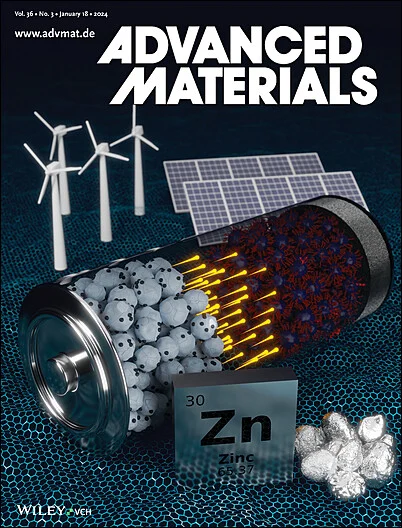Stabilizing Layered Oxide Cathodes Based on Universal Surface Residual Alkali Conversion Chemistry for Rechargeable Secondary Batteries
IF 27.4
1区 材料科学
Q1 CHEMISTRY, MULTIDISCIPLINARY
引用次数: 0
Abstract
Layered transition metal oxides (LTMOs) are attractive cathode candidates for rechargeable secondary batteries because of their high theoretical capacity. Unfortunately, LTMOs suffer from severe capacity attenuation, voltage decay, and sluggish kinetics, resulting from irreversible lattice oxygen evolution and unstable cathode-electrolyte interface. Besides, LTMOs accumulate surface residual alkali species, like hydroxides and carbonates, during synthesis, limiting their practical application. Herein, a universal strategy is suggested to in situ convert surface residual alkali into a stable polymer coating layer for LTMOs, thus turning wastes into treasure. The formation process of polymer coating involves NH4F treatment to consume residual alkali, then utilizing generated fluorides to induce the ring-opening polymerization of tetrahydrofuran. Implementing this strategy to Li-rich Mn-based cathode materials (LRM) results in a notable reduction in voltage hysteresis, along with enhanced kinetics and cycling stability in lithium-ion batteries. With this layer of encapsulation, surface lattice oxygen release and layered-to-spinel phase transition of LRM are significantly alleviated with minimal mechanical degradation and surface parasitic reactions. Such strategy can also be applied to air-sensitive sodium-rich LTMOs in sodium-ion batteries, which showcases superior universality. This work might provide a promising solution to overcome residual alkali and interfacial instability issues for LTMOs in practical application.

基于通用表面残碱转化化学的可充电二次电池层状氧化物阴极稳定研究
层状过渡金属氧化物(LTMOs)具有较高的理论容量,是可充电二次电池极具吸引力的阴极候选材料。不幸的是,由于不可逆的晶格析氧和不稳定的阴极-电解质界面,LTMOs遭受严重的容量衰减、电压衰减和缓慢的动力学。此外,LTMOs在合成过程中会积累表面残留的碱物质,如氢氧化物和碳酸盐,限制了它们的实际应用。本文提出了一种通用策略,即原位将表面残碱转化为LTMOs的稳定聚合物涂层,从而变废为宝。聚合物涂层的形成过程是通过NH4F处理消耗残碱,然后利用生成的氟化物诱导四氢呋喃开环聚合。将这一策略应用于富锂锰基正极材料(LRM),可以显著降低电压滞后,同时增强锂离子电池的动力学和循环稳定性。有了这层包封层,LRM的表面晶格氧释放和层状到尖晶石的相变明显减轻,机械降解和表面寄生反应最小。该策略也可应用于钠离子电池的富钠气敏LTMOs,具有优越的通用性。这项工作可能为LTMOs在实际应用中克服残碱和界面不稳定性问题提供了一个有希望的解决方案。
本文章由计算机程序翻译,如有差异,请以英文原文为准。
求助全文
约1分钟内获得全文
求助全文
来源期刊

Advanced Materials
工程技术-材料科学:综合
CiteScore
43.00
自引率
4.10%
发文量
2182
审稿时长
2 months
期刊介绍:
Advanced Materials, one of the world's most prestigious journals and the foundation of the Advanced portfolio, is the home of choice for best-in-class materials science for more than 30 years. Following this fast-growing and interdisciplinary field, we are considering and publishing the most important discoveries on any and all materials from materials scientists, chemists, physicists, engineers as well as health and life scientists and bringing you the latest results and trends in modern materials-related research every week.
 求助内容:
求助内容: 应助结果提醒方式:
应助结果提醒方式:


